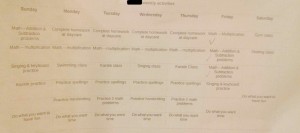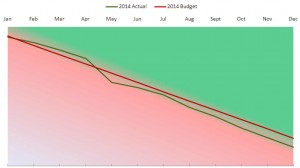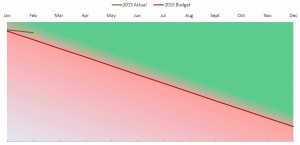Lean Kanban
We let it slide for a while. A few months actually. The Kanban board my daughter uses to track her daily work. A few weeks ago, she insisted we bring it back. When asked why she wanted the Kanban board back, she promptly replied, “I love moving the sticky to Done.” Can’t argue that. And so we brought it back.
She made changes to the board and how she wanted it to look like. At the top of the board she has a weekly plan of all the things she decided she wants to do. (see figure below). This is her weekly backlog. While I have broken it down by day to make it easy for her to follow it – she is 7, she gets to decide on the order it which she wants to do some of them. Her board has 3 columns – To Do, Doing, Done.
She gets Dojo points for completed work. At the end of the week, we tally up her points. She trades her points for stuff she wants. It’s simple and it works.
That’s how easy it is implement lean and agile practices even for personal use. In this example, the daily WIP (work in progress) is limited to the number of activities that can be performed without stressing her out. She is happy, she gets “fun time” daily and we are happy she is making incremental development progress. Sanity restored. Check!
Lean 5s
My wife is a huge 5S fan though not by that name. The 5S are:
- Sort – eliminate unnecessary items. While we do this twice a year, we are toying with a idea of doing it monthly. More importantly, the next time we want to undertake any capital expenditure, we are going to ask some tough questions. Tracking our expenses as burn-down is going to help (see below).
- Set in order – effectively store the items that has survived the monthly cull. The children and father need to just follow the lady’s lead.
- Shine – keep area clean and tidy. With two kids this is a challenge. Come to think of it, this is a perfect Kanban work item.
- Standardize – I am not really sure how to apply this one yet.
- Sustain – this is to perform the above continuously
Sanity restoration in progress.
Expense Burndown
 Last year, I got thinking about burn down charts and how useful it would be to track our finances. It’s a perfect tool. So sometime in mid-2014, I pulled out our household budget and divided it equally amongst the 12 months. I then tracked monthly spend. I knew we were going to blow our budget last year, but I wanted to track it and see if we could reign it in. The Green area above the Red line is the place to be in while avoiding the shaded area below the Red line. Overall we managed to get it within 8% of plan.
Last year, I got thinking about burn down charts and how useful it would be to track our finances. It’s a perfect tool. So sometime in mid-2014, I pulled out our household budget and divided it equally amongst the 12 months. I then tracked monthly spend. I knew we were going to blow our budget last year, but I wanted to track it and see if we could reign it in. The Green area above the Red line is the place to be in while avoiding the shaded area below the Red line. Overall we managed to get it within 8% of plan.
My wife wholeheartedly agreed that the burn down was an excellent tool to track our finances this year. Here are some policies we agreed to:
- We will not sacrifice quality of life.
- We agreed to a lower budget this year – 10% lower than last year. We wanted to see if we could pull it off by making smarter choices using lean as our guiding principle.
- We know that the actuals won’t be a straight line; i.e. we know there will be variations to the monthly spend. We expect actual spend to oscillate around the plan.
- We do expect there will be unforeseen expenses. The trick will be to anticipate some of them, have conversations around how to deal with them and figure the course of action – increase the budget or try to cut elsewhere. This is very similar to Scrum or Kanban. As you continue to burn down your work, you are always trading off time for scope. If the project budget is constrained, either time or scope will have to give. Being agile means not having to make those decisions using incorrect assumptions upfront.
 Being agile means, initiating and continuing conversations around the response plans as you go through the project but only making the decisions when you get to the bridge.
Being agile means, initiating and continuing conversations around the response plans as you go through the project but only making the decisions when you get to the bridge.
As you can see from the 2015 burn down, we are off to a promising start this year. I am also analyzing the detailed expense data to figure out where we can eliminate wasteful expenses. That should aid us making some smart choices.
It’s the culture, stupid!
Professionally, I have lived in both the Waterfall world and in the Agile world. Agile transformations start with you. I have heard similar excuses on why something new will not work in both environments. I have also seen people jump at an idea and experiment in both environments. Anecdotally, I have come to believe it’s the culture that will either make or break your agile transformation.
If you truly understand the principles that define agile, you can apply it both professionally and personally within your sphere of influence. As you make those changes, however subtle, you are in effect contributing to the change in processes and systems. Professionally, depending on where you are in the organization hierarchy, it could take time. But there’s nothing stopping you from adopting the lean and agile way of thinking to transform your life.
Care to share your agile journey below?
Way to go Adam! Thanks for sharing.
Nice work. We use a burndown for tracking our finances and are experimenting with a kanban for the kids tasks. The finance system is awesome and it’s very granular- daily in fact. We pick the steepness of our fixed line on the burndown based how fast we want to pay off our mortgage. The line is ‘ideal total debt on that day’ with the line that’s burning a total of every debt we have – credit cards, bank balances, mortgages. We add the values every day into a google doc, but smooth the line based on a 14 day payment cycle to take away any peaks and troughs due to mortgage payments out, or our salary in.
It’s been an amazing tool to get our finances in order and visible – it’s also helped us share the financial load over the year. Personal finance just does not get taught enough – there are some great tools out there to help – but i’m not sure the traditional budget is enough.